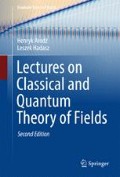Abstract
The invariant volume element in the SU(N) group (the Haar measure). The Faddeev–Popov–DeWitt determinant for a given gauge condition. The Faddeev–Popov ghost fields. The correct path integral representation of the Green’s functions of local gauge-invariant operators. Feynman diagrams for the pure non-Abelian gauge field theory. The essential role of the gauge fixing term in the classical effective action. BRST invariance of the effective action and of the measure in the path integral. The Slavnov–Taylor identity for the generating functional of Green’s functions.
Access this chapter
Tax calculation will be finalised at checkout
Purchases are for personal use only
Notes
- 1.
We will often omit the space-time index \(\mu \) of \(\hat{A}_{\mu }\) in order to keep formulas transparent.
- 2.
Let us recall that we assume that \(\omega (x) \rightarrow I_N\) when \(|\vec {x}| \rightarrow \infty \). This condition excludes, for example, \(\omega \) independent of x and different from \( I_N\).
- 3.
For brevity, we write A instead of \(\hat{A}\) if there is no risk of confusion.
- 4.
This is an assumption because we are not able to compute \(\Psi _0\), nor to prove that there exists exactly one vacuum state.
- 5.
By the free non-Abelian gauge field we mean the field \(A^a_{\mu }\) with the action that does not contain the self-interactions present in the full Yang–Mills action. Such self-interactions are switched off by equating the structure constants with zero, \(f_{abc}=0\). The resulting model contains the collection of \(N^2-1\) independent free gauge fields of the Abelian type, and it is not invariant under the full SU(N) gauge group.
- 6.
One should distinguish between gauge invariance and gauge independence. This last term, often used in literature, refers to the lack of dependence on the concrete choice of a gauge condition (12.1).
Author information
Authors and Affiliations
Corresponding author
Rights and permissions
Copyright information
© 2017 Springer International Publishing AG
About this chapter
Cite this chapter
Arodź, H., Hadasz, L. (2017). The Perturbative Expansion for Non-Abelian Gauge Fields. In: Lectures on Classical and Quantum Theory of Fields. Graduate Texts in Physics. Springer, Cham. https://doi.org/10.1007/978-3-319-55619-2_12
Download citation
DOI: https://doi.org/10.1007/978-3-319-55619-2_12
Published:
Publisher Name: Springer, Cham
Print ISBN: 978-3-319-55617-8
Online ISBN: 978-3-319-55619-2
eBook Packages: Physics and AstronomyPhysics and Astronomy (R0)

